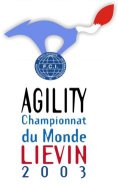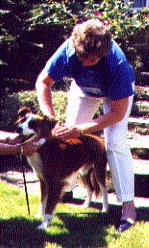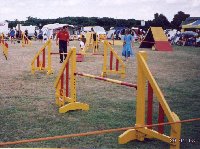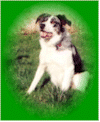| |
Agility here, there and everywhere
 People,
as we know, can be funny. Since the change in the quarantine laws, there has been much talk
about amending British agility regulations to be in line with those of the FCI, simply because
we can now take part. But much do we really know about the differences between the British and
FCI rules and regs?
International judge, trainer and former editor of Agility Voice
John Gilbert takes a look at the whole FCI debate including issues such as injuries,
jump heights and crossbreeds. People,
as we know, can be funny. Since the change in the quarantine laws, there has been much talk
about amending British agility regulations to be in line with those of the FCI, simply because
we can now take part. But much do we really know about the differences between the British and
FCI rules and regs?
International judge, trainer and former editor of Agility Voice
John Gilbert takes a look at the whole FCI debate including issues such as injuries,
jump heights and crossbreeds.
 Some
people want FCI agility opened to ALL dogs. They want to impose OUR rules on the rest of the
world, whilst not wanting THEM to impose THEIR rules on us! Some whilst trying to convince us
that they have ALL dogs at heart can’t help getting a dig in about collies! (aren’t collies
dogs also?). Others are sure that 30” jumps must be dangerous, and then let slip that their own
dog knocks poles down regularly, 24” jumps will cure that then! Whilst on the other hand there
are those who will state categorically that 24” jumps are unsafe because the dogs will go too
fast, then they will admit to owning a steady accurate dog that does well on tricky courses! Some
people want FCI agility opened to ALL dogs. They want to impose OUR rules on the rest of the
world, whilst not wanting THEM to impose THEIR rules on us! Some whilst trying to convince us
that they have ALL dogs at heart can’t help getting a dig in about collies! (aren’t collies
dogs also?). Others are sure that 30” jumps must be dangerous, and then let slip that their own
dog knocks poles down regularly, 24” jumps will cure that then! Whilst on the other hand there
are those who will state categorically that 24” jumps are unsafe because the dogs will go too
fast, then they will admit to owning a steady accurate dog that does well on tricky courses!
Everyone knows someone who has visited
a country once or twice, or knows a friend who has, or is a regular armchair agility enthusiast
on the NET, who then becomes an expert on that countries agility set up, passing it onto others
via the many media outlets. Unfortunately most of what they pass on is completely wrong and
gives a totally false impression of agility in other countries.
I am always a bit suspicious when
someone starts off 'What they do in XYZ is...' - all based on seeing one or two bits of
agility. The same is true when I hear some people abroad talking about British Agility. They
tell me, for instance, that we don’t train for contacts, because we only want SPEED! and many
of our dogs are cripples from jumping too high! They KNOW it’s correct because they have spoken
to someone in England who told them!
 The FCI The FCI
Nothing is more
confusing than when it comes to talking about the FCI (Federation Cynologique Internationale.)
The FCI is a world organisation concerned with Pedigree dogs. Many countries across the world
(not just Europe) are full members, many are affiliated, and some are just friendly with, or
have reciprocal agreements. Each of these countries have their own domestic Rules and
Regulations, but if and when they hold or take part in international competitions sanctioned by
the FCI, they then must of course follow the FCI Regulations.
If Britain, as a friendly non-member,
wants to take part in the FCI World Agility Championships, and as I understand it, we have
asked and been accepted, then it naturally follows that we to must accept their Regulations for
this event. If, however, we want to change some of the Rules and Regulations and generally have
an input, then we first need to become a part of the organisation in some form or another to
join in their discussions about Rules and Regulations. Even if we could have someone only as an
observer attending the FCI Agility Commission meetings, it would be a giant step forward in
keeping us fully up to date with what is currently being discussed, rather than getting this
information third hand (and incorrect) through the grapevine.
 Injuries
- a very complex debate Injuries
- a very complex debate
Having been involved in training dogs for more than thirty years, twenty in the case
of agility, I still wouldn’t need to use both hands to count the number of injuries that I have
actually seen happen. I have seen accidents, both at training and in competition, but rarely
did these result in an injury.
Having said that, of course we cannot
know unless a complete and accurate study is carried out, whether injuries occurred later, or
indeed if injuries occurred over a period of time just from training and competing. Whether
tendon injuries occur from dogs hitting the slats on contact equipment is a matter for
conjecture. In my experience of training thousands of dogs, I have observed that very few dogs
- apart from minis - actually touch the slats.
What I would say about slats is that
it is totally unnecessary for them to be too thick. A quarter of an inch or less is ideal. It
may be that the equipment with the much thicker slats - and I have seen them up to three
quarters of an inch thick - could be responsible for foot damage? The suggestion to delete the
slats from the see-saw is purely on the grounds of safety in that many inexperienced dogs, when
faced with slats on this obstacle, confuse it with the dogwalk and continue to climb up at
speed when, in fact, the obstacle is falling away from them.
Agility like any physical sport cannot
be injury free, but we can always learn to do things better and, if necessary, make
recommendations or changes to make things better. We must always have the safety of our sport
uppermost in our minds at all times, inside and outside of the competition ring. I think on the
whole that we achieve this now, but we must never be complacent, and likewise must also not be
too hasty should one unfortunate injury befall one
unfortunate dog.
One thing of which I
would agree is that chiropractors will see and report more injuries now than say, five years
ago. More agility dogs are going to see them, or being sent by trainers like me when we see a
dog that is not performing 100%. Far better that the dog
is looked at, diagnosed, sorted out and cured, than say, ten years ago when the only treatment
was rest and lead walking. In many cases, they never really got to the root of the dog’s
problem, so it carried on in agility with an injury, albeit underachieving.
Someone has already said that if it
were a pet dog NOT doing agility the injury may well never have been discovered, how true ! In
other cases the chiropractor may well diagnose an injury for which a cure cannot be maintained
if the dog continues to do agility, at least the owner now knows, and can make a decision based
on knowledge, in the past the dogs non-performance may well have been put down to bad training
or a stupid dog! Rather than stating the fact that chiropractors, Osteopaths, Veterinary
Surgeons etc are seeing more agility dogs with injuries and everyone concluding that 'Ah well,
that MUST be the so and so that’s causing that, I always thought so.' What we need to be very
helpful is, numbers, facts, type of injury, age, time in agility etc, etc, etc, information and
recommendations that can be discussed objectively.
 Jump
heights Jump
heights
There is to my knowledge NO recommendation from anyone to change any of our Agility Rules and
Regulations in favour of those of the FCI. There is
however, since the change in the quarantine laws, much debate and interest on the subject
because we can now take part. Someone was asking if
there was an historical reason for our jump heights and why didn’t the rest of the world follow
us in the first place.
Originally, some
people may be surprised to know, our jump height was 36” not 30”, and since Agility was
invented by a Working Trials man, (Peter Meanwell) and Working Trials people were the first to
take part, it’s not so surprising that the height of a Working Trial clear jump was used as a
yard stick. However as soon as non-Working Trials dogs started to be interested in this new
sport, it was obvious that 36” was too high, and so it was changed to a maximum of 30” and has
remained so to this day.
Many people, myself included, believe
that 30inches
is the perfect jumping height for an agility dog.
It’s a good test without being too
hard for the majority of dogs. The size of the obstacles in relation to the course lends itself
perfectly to this height, and it is the optimum height to achieve the 'jumping curve' effect
that is so pleasing to the eye when negotiated to perfection. Having said that, if it can be
proved that it would benefit agility to change this height, or there is a swell of opinion to
do so then, of course, I would be willing to listen.
As far as the rest of the world
was concerned, they did initially follow our lead, but in 1995 the FCI reduced their top height
to between 55cm and 65cm (21 5/8” – 25 5/8”.) Countries have come to this height from different
angles, some were heavily influenced by a report that stated dogs jumping 30” were far more
likely to sustain long term injuries than dogs jumping just over 25” !!! and as a lower height
suited more people than it didn’t, the rest was easy. Other countries were dominated by breeds
that are generally smaller than in the UK, so once again, lowering the height met with little
opposition. Once it was obvious that some countries were in favour, and considering that unlike
us, many European countries were already 'playing together' it was almost a forgone conclusion
that the FCI would be subject to change.
I have to say from my experience of
teaching and judging many times in 20 countries around the world that I have found that it
makes little or no difference whatever the jump height is. When judging I have always designed
courses exactly the same as I would here in the UK and indeed judged exactly the same without
any problems whatsoever. The same percentage of knock-downs occur on 65cm or 75cm jump heights.
The European dogs go just as fast as some of ours - in some cases faster - but have no problem
in negotiating the contact equipment coming from a lower trajectory jump, as our Elementary
dogs have no problem when their jumps are set at 24”, indeed is it not the same as our fast
dogs exiting from a tunnel onto an A-ramp?
 Pedigree
dogs/crossbreeds Pedigree
dogs/crossbreeds
There is much talk about why Crossbreeds are not allowed in the FCI World Championships.
Having explained briefly about the FCI, we have to accept that at the moment it is their rule.
However, it is not true to say that crossbreeds are discriminated against in World Agility. In
almost all countries Crossbreeds and Pedigrees compete on an equal footing as in the UK. A
Crossbreed can also become a national champion in many countries. The only restriction that I
know of for Crossbreeds is that they cannot qualify for the World Championships or enter a
CACIAG competition. (This is an FCI class to qualify as an International Champion.)
British Agility without Crossbreeds
will never happen. It’s just scaremongering, and the rescuing of dogs will not diminish
 because
of a World Championship for Pedigrees. The FCI cannot dictate, and does not dictate to any
country in regard to their domestic arrangements. If a country wishes to follow the FCI rules
and regulations lock, stock, and barrel, it’s their choice, but as far as I know there is no
country that adopts this way. because
of a World Championship for Pedigrees. The FCI cannot dictate, and does not dictate to any
country in regard to their domestic arrangements. If a country wishes to follow the FCI rules
and regulations lock, stock, and barrel, it’s their choice, but as far as I know there is no
country that adopts this way.
Maybe instead of constantly indulging
in FCI bashing, we should be working towards a more positive solution. If we were to get a
voice within the FCI Agility Commission, and fully explain the situation as it exists in the
UK, it might be possible to achieve some concessions or compromise. For instance, hardly anyone
abroad can grasp the fact that there IS a difference between two identical black & white dogs
because one is a Border Collie (BC) and the other is a Working Sheep Dog (WSD). What about us
here in the UK. trying to get the WSD recognised as a breed? I appreciate that doesn’t solve
the problem for all the other Crossbreeds, but maybe it’s a start.
 It
has been stated that the FCI World Championships cannot truly be called 'World' when a number
of dogs are not allowed to compete, and this has lead to the organisation of an 'alternative
World Championships' by people who feel strongly about the FCI’s restrictive policy. There is
nothing wrong with holding another competition, but how can this be an 'alternative'
(presumably meaning better), when so many more dogs would be restricted simply because they
come from countries whose dogs are not allowed into Britain? It
has been stated that the FCI World Championships cannot truly be called 'World' when a number
of dogs are not allowed to compete, and this has lead to the organisation of an 'alternative
World Championships' by people who feel strongly about the FCI’s restrictive policy. There is
nothing wrong with holding another competition, but how can this be an 'alternative'
(presumably meaning better), when so many more dogs would be restricted simply because they
come from countries whose dogs are not allowed into Britain?
The suggestion that the current World
Champion, Christine Charpentier and her Border Collie Mac are not worthy winners because there
could be better dogs that were excluded, is too ludicrous to even contemplate, if you had ever
seen this young lady and her dog you wouldn’t even pose the question!
Every year the FCI World Championship
are held, they are just like the Olympics, bigger and better with more countries participating,
hardly a recipe for a dead loss competition! Knowing as I do quite a bit about Italian Agility,
the competition held there for non-registered dogs was not in answer to the FCI elitist Trial,
but people will pick up on anything to strengthen their own argument.
Change? What change?
To change British agility regulations in line with those of the FCI is almost unthinkable
to many in the UK, but do many people even know what the differences are between UK and FCI
rules and regs! Much of
what we do now I can assure everyone is exactly the same, after all they got it from us in the
first place!
 The
most noticeable differences are:- The
most noticeable differences are:-
- Weaving poles – Only even
numbers can be used.
- Age of dog – 15 months is
the minimum age to start.
- Jump heights – Lower as
previously discussed.
- Classification – All
handlers can compete in STARTERS.
- Table – The dog’s position
on the table is judges discretion.
- Clubs – Handlers must belong
to a registered club to compete
Now a quick look at this list and I am
sure that many handlers would have no hesitation in accepting points 1-4 because they are
beneficial to them personally, but whether they are in the interest of our domestic agility
generally, would need to be the subject of much debate.
About the
author...
John Gilbert started Dog Training in 1967 with a German Shepherd called
Heidi, together they went on to compete in Championship classes in Obedience as a 'C' only dog.
Throughout the next ten years John was competing regularly in Obedience During this time he had
also become an instructor at the Hemel Hempstead BAGSD, but it was in 1978 when Dog Agility
started that things moved very quickly for John.
With his next German Shepherd Becky
John was one of the top competitors in those early days of Agility, qualifying for the Olympia
finals six times as well as winning dozens of other competitions. Up to the present time John
has trained and handled four dogs to Senior (A3) level.
When the sport of Agility became
official in 1980 John was instrumental in forming the rules of the sport and became one of the
first people to judge. He has since judged every major event in the UK and also judged in over
19 countries throughout the world including twice judging at the FCI World Dog Show.
In the late 1980’s John Started his
own private training centre for Obedience and Agility and became a professional trainer full
time. Since that time his teaching expertise has been in constant demand both at home and
abroad. Travelling the world teaching judges, instructors and handlers has become a passion
that John relishes with enthusiasm.
| |
|